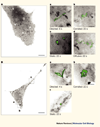Imaging gene expression in single living cells
- PMID: 15459666
- PMCID: PMC4942131
- DOI: 10.1038/nrm1494
Imaging gene expression in single living cells
Abstract
Technical advances in the field of live-cell imaging have introduced the cell biologist to a new, dynamic, subcellular world. The static world of molecules in fixed cells has now been extended to the time dimension. This allows the visualization and quantification of gene expression and intracellular trafficking events of the studied molecules and the associated enzymatic processes in individual cells, in real time.
Figures


References
-
- Gerlich D, Ellenberg J. 4D imaging to assay complex dynamics in live specimens. Nature Cell Biol. 2003;5:S14–S19. - PubMed
-
- Zimmermann T, Rietdorf J, Pepperkok R. Spectral imaging and its applications in live cell microscopy. FEBS Lett. 2003;546:87–92. - PubMed
-
- Patterson G, Day RN, Piston D. Fluorescent protein spectra. J. Cell Sci. 2001;114:837–838. - PubMed
-
- Peercy PS. The drive to miniaturization. Nature. 2000;406:1023–1026. - PubMed
-
- Carrington WA, Fogarty K, Fay FS. In: 3D fluorescence imaging of single cells using image restoration. Foskett K, Grinstein S, editors. New York: Wiley–Liss Inc.; 1990.
Publication types
MeSH terms
Substances
Grants and funding
LinkOut - more resources
Full Text Sources
Other Literature Sources
Medical
Molecular Biology Databases

